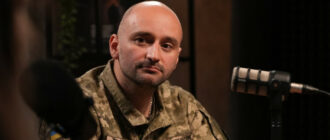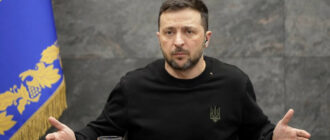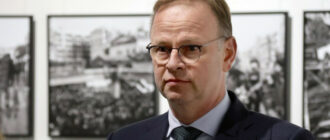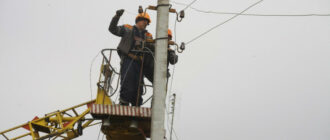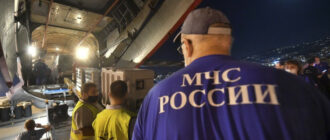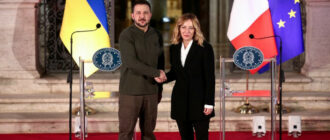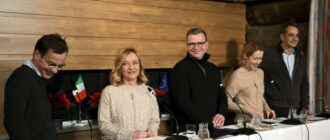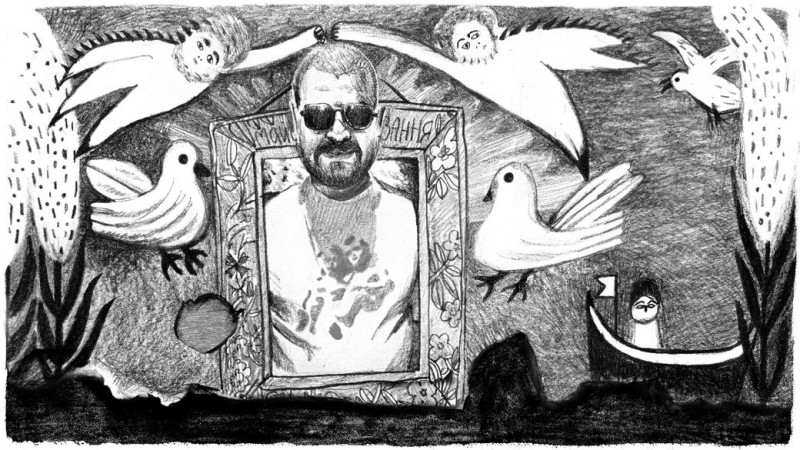
“Viacheslav turned the artistic life of Kherson upside down”. Viacheslav Mashnytskyi founded the Museum of the Kherson Contemporary Art and the Polina Raiko Charitable Foundation. At the end of October 2022, right before the liberation of the part of Kherson region, Mashnytskyi’s relatives and friends lost contact with him. Illustration by Inga Levi
Artist and curator Viacheslav Mashnytskyi, who remained in Kherson after the occupation of the city, went to pro-Ukrainian rallies and tried to preserve the collection of his museum, disappeared. Crimean street artist Bohdan Ziza, who splashed the yellow and blue paint on the building of the Yevpatoria city administration captured by the Russians, was "sentenced" by Russia to 15 years in prison. Theater director Anatolii Levchenko, who staged Ukrainian plays in Mariupol, spent almost 10 months in the Russian captivity.
There are dozens of such stories. They tell how Russia kills, kidnaps, and captures artists in the occupied territories because they refuse to cooperate, resist, and most importantly, because they represent Ukrainian culture. "I just wanted to stage plays by Ukrainian playwrights," says one of our characters.
Culture is an important component of identity, which the Russians are trying to destroy in the occupied territories in the first place. Suspilne tells the stories of Ukrainian artists who resisted this.
Viacheslav Mashnytskyi: "Our land does not let them in"
The Kherson artist and curator went missing in October 2022 during the occupation. His family and friends are trying to find out what happened to him and are continuing his work.
In one of the videos that Viacheslav Mashnytskyi posted during the occupation, he says, "I would like to make visible the things that are invisible". From the time when the artist returned to his native Kherson in 2002 and until his disappearance in October 2022, he was fulfilling this task — he was making the contemporary Kherson art visible. "Viacheslav was constantly generating ideas, constantly wanted to see something new, we traveled a lot in Kherson region — both by car and on boat. He was curious about the world and about life, and inspired others with this," says Oleksandr Yevstafiev, a friend of the artist.
Viacheslav Mashnytskyi was born in Kherson in 1964 in the family of artist Valerii Mashnytskyi. He studied in Odesa and Kyiv, worked for some time in the capital of Ukraine and in Moscow, and returned to Kherson in 2002. In two years, together with painter Stas Voliazlovskyi, he founded the Charitable Foundation named after artist Polina Raiko, which popularizes her legacy and supports local creative initiatives. He converted his apartment into a gallery, which later became the "Museum of Contemporary Art Kherson".
"Viacheslav demolished the interior wall between the rooms and the corridor. Artists just painted on the walls and that was the first exhibition," says Hanna Mashnytska, Viacheslav’s wife. "Viacheslav understood that it was sometimes difficult for me to live in a museum, but he said, "We have such a mission, we ourselves are exhibits". This museum was his territory. That is why he did not leave the city after the occupation — he had to take care of it."
When the Russian army entered Kherson in 2022, Mashnytskyi refused to take out the museum collection. He believed that the less attention he attracted, the more likely the occupiers would not pay attention to him. At that time, the collection included the works of Stas Voliazlovskyi, Polina Raiko, representatives of local naïve art, and members of the Kyiv Parkomuna.
"We went to rallies on Heavenly Hundred Square. When a man with a Ukrainian flag climbed onto a Russian armored personnel carrier, Viacheslav said, "Victory is also a kind of art". He was waiting for the liberation of Kherson and used to say, "I see they are not for long here. Our land does not let them in; the ground is shrinking beneath their feet. I want to see them running away from here". Viacheslav went missing less than a month before the liberation. While Russian troops were in Kherson, Mashnytskyi spent most of his time in his summer cottage on Great Potemkin Island. The artist’s wife says that atmosphere there was not so oppressive as in the city with its checkpoints, armed occupiers and Russian flags. "Viacheslav loved this southern culture of summer cottages. A boat, motor, tackle, stove. He liked to go fishing, to salt and dry fish, to make apple juice and wine. He had a rest there, "rebooted" himself. It was even more important during the occupation. In the summer, he brought a projector there and showed films for children. He wanted to be as far as possible from the occupiers who had already visited him."
The occupation authorities offered Viacheslav to take one of the leading positions in the field of culture. "Viacheslav refused and said he had other things to do," says Hanna.
On October 17, 2022, Mashnytskyi stopped responding to messages, and his wife was alarmed. The next day she went to the summer cottage. That day, Oleksandr Yevstafiev wrote on the social media about the disappearance of his friend, "Today, outer clothing with traces of blood and an overturned table were discovered in Viacheslav’s summer cottage. The "Dnipro" boat and the engine for the "Suzuki" boat are missing."
His friends started a search, and Hanna Mashnytska went to the Ukraine-controlled territory to file a report about the disappearance of her husband. The investigation is ongoing. Meantime, Viacheslav’s friends take care of his collection and continue what he started: they hold exhibitions, released a catalog for the 20th anniversary of the museum founded by Mashnytskyi, and exhibit Viacheslav’s works. They say, "Wherever he is now, Viacheslav is here!"
"It is so difficult to talk about all this," says Hanna. "Viacheslav turned the artistic life of Kherson upside down, but he influenced my life even more. He is an amazing person. With each month, the hope is vanishing, but I still hope Viacheslav is alive and we will find him, he will return. Right now, we just want to find out what happened in the summer cottage."

Mashnytskyi was last seen in his summer cottage on Great Potemkin Island near Kherson. Viacheslav’s outer clothes with traces of blood were found in his summer cottage. Illustration by Inga Levi

